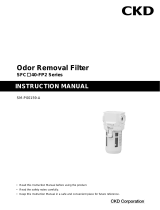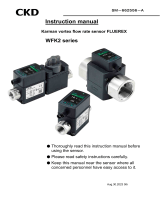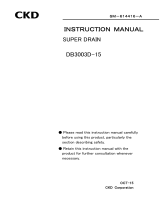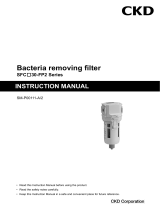
Please read this instruction manual
carefully before using this product,
particularly the section describing safety
Retain this instruction manual with the
product for further consultation whenever
necessary
Jun-14 2nd edition


Thank you very much for purchasing our Main Line Filter .
This manual explains basic poi
nts of installation, operation, etc. to have our
Main Line Filter perform at their best. Be sure to read this manual before
using your
Keep this booklet handy for quick reference.
Please be advised in advance that there may be some discrepancies
between products and contents of this book due to improvement of
specification after printing.


Specifications
Note1. Treating air flow rate is the atmospheric pressure conversion value where inlet
pressure is 0.7MPa.
Note2. ANR shows conditions where 20 atmospheric pressure and relative humidity 65%.
Note3. Secondary side oil content density is the value where inlet air temperature is 21.
Note4. Min. operating pressure of a automatic drain is 0.1MPa.
Initially generated drainage and air purged until pressure reaches 0.1MPa.
Note5. P/M type filter element is spent when DP indicator red zone or one year of use,
whichever is sooner.
Note6. Replace X type element after 650 hours (at 21) of use or when the deodorizing effect is
lost.
Note7. In X type, the ball valve has adhered to the drainoutlet.

External dimensions
D dimension is a lower limit necessary to remove the element. Actually install it in consideration
of piping dimensions of the automatic drain.

(1) Air flow rate through Main line filter must not exceed processed air flow rate.
Otherwise, water and/or dust in compressed air could not be removed.
(2) Use it within the range of the use temperature. The following malfunction, damage,
and air leak when using it outside the range.
The element freezes, the differential pressure grows, and the element is
damaged.
Poor drainage by freezing automatic drain, or air leakage from automatic drain
because of frozen damage.
Leakage from automatic drain due to automatic drain strength decrease at high
temperature.
Malfunction or damage of differential pressure indicator at high temperature.
(3) When pressurizing Main line filter which is set-up in front or in the rear of valves,
operate valve, etc. slowly. Rapid operation of valve may damage filter element and
DP indicator.
(4) Avoid using this product where vibration and impact are present.
(5) When releasing pressure from piping, release it slowly at secondary side of Main
line filter. If released at primary side, reverse flow may arise in Main line filter,
resulting in damage of DP indicator and element.
(6) Do not use the dryer for pneumatic caisson shield or respiratory medical equipment.
It could cause an accident includes injury.
(7) Do not use the dryer for transportation devices such as automobile, ship etc.
Vibration could be a cause of break down of the internal components.

3-1. Prior to opening air valve
Ensure the following check points after completion of installation Main line filter prior to
opening air valve.
1) Whether drain discharger(X type is not required)are properly installed, confirm
whether to be given it to the drain piping.
2) Ensure that the air flow is within max. tolerable flow rate.
3) Confirm whether the direction of the flow of air is corresponding to the method of
installing the main line filter.
It indicates that the system is operable when no discrepancies is discovered.

Place of installation
1) Do not the Main line filter in a place where it is likely to be exposed to direct sunlight
and rainwater.
2) Make use of working temperature range.
3) Do not set it up in outdoor.
4) Do not use it in a place that might freeze. Because a drain freezes, Main line filter
likely to breakage.
5) Inlet air temperature must low as low as the Main line filter can use. Because Oil
removal rating down by inlet air temperature is high.
6) Do not use the Main line filter in place where it is likely to danger(blowing up
possible an atmosphere).
7) Avoid using this product where vibration and impact are present.
8) Provide ample room around it for later service such as replacing element or
dismounting bowl.
4) Avoid its installation within the area where such gases as follows are likely mixed in
the ambient air because element may be eroded or swollen.
Sulforous acid gas
Clorate gas
Hidensity ozone
Arlmatic hydro carbons solvent
(Examples; Benzene, Toluen, Phenol, Cyclohexane etc.)
Chlorinated aliphatic hydrocarbons
(Examples; Trichloro ethylene, Chlorohorm etc.)
Keton (Example; Aceton)
Aldehyde (Examples; Holmaldehyde, Acetoaldehyde etc.)
Amin (Examples; Ethylamin, Methyl amin etc.)

4-2. Installation
1) Install it to endure the weight of the product enough. It might cause the injury by the
water leak and the fall etc. when there is incompleteness in the installation.
2) Do not mount the Main line filter in front on in the rear abrupt open/close valve.
3) Install it so as to have arrow mark coincides with direction of flow.
It may sometimes cause a damage of element and DP indicator when back
pressure is charged to Main line filter.
4) Install it as perpendicular as possible having drain port downward.
5) Install it as far away from compressor as possible so as to have compressed air
cools by natural radiation in piping before coming into filter.
6) Keep primary pressure within 1.0MPa.
7) For the exchange of the filter element, take it as possible than a floor face greatly.
Do easy setting in consideration of length of the drain piping.
8) Since the lower part may move to a vertical direction at the time of
pressurization, AF2026 series should shift the lower part
beforehand to perpendicular down at the time of installation.
More than E (
Element exchange
dimensions
)

4-3.Piping
1) Use large enough pipe to reduce pressure drop and eliminate sharp bending of
piping or using stop valve with large flow resistance.
2) It is recommended to use zinc coated pipes to prevent rusting or stainless pipe.
3) Wash off cutting oil and/or rust preventive oil off the pipes and couplings.
4) Be sure to set M type before X type. Also, do not forget to install the air dryer before
operation.
5) Separated oil of compressed air by Main line filter is automatically purged by
automatic drain.
6) The port size of the drain discharge is Rc1/8. The drain pipe must be more than ID
5.7 and within 5m in length and must not be installed upward.
7) The drain is drained by pressure. Be careful so that I fix the piping well, and spray of
water does not hang to a person and the thing.
8) Lay the drain pipe so that it is not pressurized. Laying several pipes together or
attaching a check valve will create a pressurized state. Do not lay the pipes in this
state.
9) Fix with the attachment lug with the floor face and the ceiling, etc. when the
connection piping is long or the load might join the piping part.
10) The filter is sure to be fixed with the pipe wrench and piping must screw in when
you lay pipes. Port and the root are transformed, damaged when impossible power
is added to port with the connected piping, and it causes the air leakage.
11) The valve clings under the filter. When maintaining it, it uses it to pull out internal
pressure.
12) When air compressor is not stopped when elements are exchanged, we will
recommend the bypass piping.
13) The flushing after the construction removes an element, and please carry it out.
valve

5-1. Timing of element replacement
1) P/M type filter element is spent when DP indicator red zone or one year of use,
whichever is sooner. Discard clogged element because it is not washable.
2) X type absorbs odor by means of activated carbon. Because of this, a differential
pressure cannot be used to measure its operation life. Replace the element when
every 650 hours or its deodorizing power begins to deteriorate.
Note that the duration shortens when the insertion
temperature degree is high.
The element at the end of its life cannot be revived
by washing. Replace it with a new one.
5-2. Replacement procedure of element
1) Stop supplying compressed air and release
pressure in filter.
(Do not release pressure from primary side.)
2) Remove bowl
The bowl is turned left. The bowl is removed below.
3) Replace element
After the element is pulled out up and detached, the element
for a new exchange is inserted in the bowl.
Temperature
Time

Confirm the element is correct in the bowl and exists.
4) Install bowl
5) The record can be described to the sticker pasted to
the bowl side and use it.
Mark
Mistake
The bowl is returned to
former position.
Turn the bowl to the
right and shut.
Confirm the position of
the mark is suitable.

5-3. Inspection of automatic drain
A separated drain has to be discharged to outside certainly by an element of a filter.
Visually inspect occasionally to confirm its appropriate functioning. Disassemble and
clean it or replace with a new drain unit.
5-3-1. Replacement of automatic drain
1) Stop supplying compressed air and release pressure in filter.
( Do not release pressure from primary side.)
2) Autodraincup is turned and it removes.
3) Cap screw is removed and an upper cap is removed. It's difficult
for adherence to remove because it's being sealed up with a
gasket.
4) Hexagon nut is turned and an automatic drain is removed.
The automatic drain can be fixed by putting 3mm hex key from a
hexagon nut. Next, turn the hexagon nut.
5) Change it for a new auto drain and the gasket.
6) The autodraincup is built oppositely. And, it firmly attaches it to
the bowl. Autodraincup
Cap screw
Hexagon nut
Packing
Autodrain
Hex key

Expendable parts
is indicated by type P M X
O-ring kit is 3 for the element and 1 for the bowl.
Autodrain is a set of the float
assembly, the hexagon nut, and
the gasket.
X type does not have automatic drain.
is indicated by type P M X
Automatic drain
O-ring kit
Element

Accessories
Bracket kit
Module kit
DP indicator

–
Flow rate Element type
Solid/oil removal
High performance solid/oil
removal
Odor removal
Port size

/










